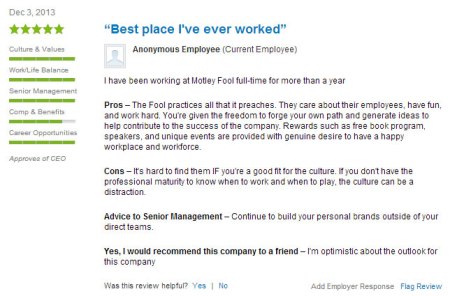Glassdoor is an online employment portal that lets employees rate the companies they work for on multiple criteria like compensation, culture, CEO’s effectiveness and more. Its ratings model is unique because, unlike corporate research publications, Glassdoor’s company ratings are completely crowdsourced. This opens up a goldmine of opportunities for companies to get on Glassdoor’s radar as a great place to work. So how can you leverage this aspect of Glassdoor to get your company rated as a cool place to work?
Benefits of Glassdoor
- Glassdoor offers multiple awards and badges that add to a company’s prestige. Awards and publications by Glassdoor include: Best Places to Work, Highest Rated CEOs, Top Companies for Career Opportunities, Top Companies for Work-Life Balance, and more. Companies can, and do, showcase these badges on their website to build their credibility.
- Glassdoor’s reports are quoted in mainstream media outlets such as the Huffington Post, Forbes, Techcrunch and more. Such worldwide exposure affords companies free publicity.
- Companies featured on Glassdoor with positive reviews tend to attract top talent. Qualified candidates want to work for companies that existing employees speak well of in a public forum.
- Companies gain access to unbiased employee reviews and can see competitive insights which help them tweak their talent and recruitment strategies.
How to Get High Ratings on Glassdoor
Assuming that you have laid the ground work in establishing a great company culture and people enjoy coming in to work at your company, you can encourage your employees to participate on Glassdoor using the following steps:
Step 1: Sign Up For a Free Employer Account
You can sign up for a free employer account which will help you see who’s viewing your company’s profile, allow you to update your company information and recruit top talent.
Step 2: Ask Employees to Sign Up For Glassdoor Using Facebook
Ask your employees to sign up for Glassdoor’s Facebook app. Glassdoor integrates with Facebook to help people find out which friends are working in which company. Even though all reviews are anonymous – an important point to stress to your employees – Facebook activity may show up in users’ newsfeeds. This will help encourage more people to sign up since their peers are doing so.
Step 3: Ask Employees to Write an Honest and Balanced Review
Since Glassdoor allows “only one company review per employee a year”, do make it count! Encourage employees to voice their opinion on what it’s like to work at your company so that others may benefit from their years of experience. Help employees understand that you are building the company’s culture together, since what they write will shape the opinion of future employees. You can even convert this into an annual event, where all employees write or update their company’s review on Glassdoor every year. This way, your company’s reviews are always fresh and of value to prospective candidates.
Step 4: Respond to All Reviews
When you respond to reviews – both positive and negative – you get a chance to showcase your company’s transparent approach and communicative nature. Future job candidates will see you as a company that actively listens to and responds to feedback. While responding to reviews, ensure your tone stays positive and that you remain transparent.
Step 5: Share Reviews on Social Networks and with Media Outlets
Once your reviews and responses are in place, it’s time to get promoting! Share the reviews on all your social networks and encourage your employees to do so too. Send your company ratings to your local media and write a press release to encourage them to find an angle on your company’s story. For example, if many of your employees say that the food/catering is awesome at your company, that could be a “hook” that journalists can use to write about your company as a great place to work.
Glassdoor won a webby award for the “best employment site 2012”. Its various reports continue to be highlighted publicly in the media and are fast becoming a resource for finding insider information about any company. Now is the time to claim your company profile on Glassdoor and take control of it. After all, which other mainstream job site offers you crowdsourced ratings that you can use to your advantage?
Is your company on Glassdoor? Do you think employees reviews can help your organization become known as a great place to work or would it open Pandora’s Box? Do share your thoughts in the comments below.
– Paul Keijzer
You may also like:
Work Place Infidelity
Democratic Enterprise















